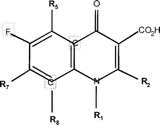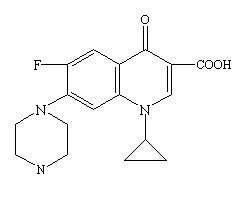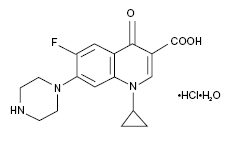Ciprofloxacin
From Proteopedia
| Line 78: | Line 78: | ||
<scene name='Sandbox_100/Spec_grn_dna_interruption_cipr/2'>Interrupted DNA in green</scene> | <scene name='Sandbox_100/Spec_grn_dna_interruption_cipr/2'>Interrupted DNA in green</scene> | ||
| + | |||
| + | |||
| + | |||
| + | |||
| + | |||
=== Efflux Pump Target === | === Efflux Pump Target === | ||
<Structure load='1OYE' size='350' frame='true' align='right' caption='AcrB Multidrug Efflux Pump with Attached Ciprofloxacin' scene='Insert optional scene name here' /> | <Structure load='1OYE' size='350' frame='true' align='right' caption='AcrB Multidrug Efflux Pump with Attached Ciprofloxacin' scene='Insert optional scene name here' /> | ||
| + | |||
| + | |||
Revision as of 04:32, 8 March 2011
| Please do NOT make changes to this Sandbox until after May 10, 2011. Sandbox 100 is reserved until then for use by John Ripollone - Messiah College, Grantham, PA (under the supervision of Dr. Hannah Tims). |
Contents |
Ciprofloxacin
Page under construction - by: John Ripollone, Department of Biological Sciences (in conjunction with the Department of Chemistry and Biochemistry) - Messiah College, Grantham, PA 17027.
General Information
|
Ciprofloxacin is a broad-spectrum synthetic fluoroquinolone antibiotic that is generally effective against both aerobic gram-positive and aerobic gram-negative bacteria[1]. Bacterial organisms that have been shown to be efficiently targeted by ciprofloxacin are:
Aerobic Gram-Positive Bacteria (With Certain Strain Particularities):
Enterococcus faecalis (many strains are only moderately susceptible), Staphylococcus aureus (methicillin-susceptible strains only), Staphylococcus epidermidis (methicillin-susceptible strains only), Staphylococcus saprophyticus, Streptococcus pneumoniae (penicillin-susceptible strains only), Streptococcus pyogenes.
Aerobic Gram-Negative Bacteria:
Campylobacter jejuni, Citrobacter diversus, Citrobacter freundii, Enterobacter cloacae, Escherichia coli, Haemophilus influenzae, Haemophilus parainfluenzae, Klebsiella pneumoniae, Moraxella catarrhalis, Morganella morganii, Neisseria gonorrhoeae, Proteus mirabilis, Proteus vulgaris, Providencia rettgeri, Providencia stuartii, Pseudomonas aeruginosa, Salmonella typhi, Serratia marcescens, Shigella boydii, Shigella dysenteriae, Shigella flexneri, Shigella sonnei.
Ciprofloxacin also exhibits in vitro minimum inhibitory concentrations of 1 μg/mL or less against strains of the following bacteria (with less adequate characterizations of the effects of treatment against these bacteria in terms of efficiency and general safety):
Aerobic Gram-Positive Bacteria (With Certain Strain Particularities):
Staphylococcus haemolyticus, Staphylococcus hominis, Streptococcus pneumoniae (penicillin-resistant strains only).
Aerobic Gram-Negative Bacteria:
Acinetobacter Iwoffi, Aeromonas hydrophila, Edwardsiella tarda, Enterobacter aerogenes, Klebsiella oxytoca, Vibrio cholerae, Legionella pneumophila, Vibrio parahaemolyticus, Pasteurella multocida, Vibrio vulnificus, Salmonella enteritidis, Yersinia enterocolitica.
Most anaerobic bacteria exhibit Ciprofloxacin-resistance.
The effectiveness of Ciprofloxacin against the anthrax-causing bacteria, Bacillus anthracis - both in vitro and by use of surrogate marker serum levels - has also been demonstrated[2][3]. Thus, Ciprofloxacin is currently a Federal Drug Administration (FDA)-approved treatment for patients who have been exposed to anthrax via inhalation[4]. Likewise, Ciprofloxacin may be used to treat plague (from the bacteria, Yersinia pestis) and tularemia (from the bacteria, Francisella tularensis[5]. Thus, Ciprofloxacin demonstrates usefulness in the field of counter-bioterrorism given its action against bacteria that could potentially be implemented in biological warfare. Furthermore, in its extended-release tablet form, Ciprofloxacin tends to target, specifically, certain types of urological infections (e.g. epididymitis). The nature of Ciprofloxacin, then, as a powerful, broad-range antibiotic is crucial for broad-range bacterial infection treatment. An understanding of the action of Ciprofloxacin at the molecular level is, no doubt, necessary for an appreciation of the potency of Ciprofloxacin as witnessed at the macro level.
Historical Information
The patented introduction of Ciprofloxacin in the United States occurred in 1987 as a result of the research efforts of Bayer Pharmaceuticals, although there have been reports that at least two European patents had pre-dated the Bayer patent by at least five years[6]. On October 27, 1987, the Federal Drug Administration (FDA) had approved the drug for use in the United States for the treatment of certain bacterial infections. The effectiveness of Ciprofloxacin as an antibiotic went unchallenged by all alternative antibiotics[7]. Thus, other pharmaceutical companies were forced to offer their alternative antibiotics at lower costs (compared to the cost of Ciprofloxacin) so as to engage any sort of competition with Ciprofloxacin. Because of the tendency of doctors to prescribe lower-cost medication, Bayer Pharmaceuticals could not expand into the international pharmaceutical industry (which, as a whole, was steadily declining) and, consequently, was forced to downsize at the turn of the century. Indeed, the competitive effectiveness of Ciprofloxacin did not overcome the competitive pricing of drugs released by alternative pharmaceutical companies. Faced with the impending expiration of its patent for Ciprofloxacin in the early years of the millennium, Bayer Pharmaceuticals attempted to release variations of Ciprofloxacin. The release of Ciprofloxacin variations such as Pediatric Ciprofloxacin and Once-daily Ciprofloxacin allowed for the extension of the Bayer Pharmaceutical Ciprofloxacin patent. The popularity of Ciprofloxacin rose sharply after September 11, 2001 due its characteristic targeting of anthrax, which was projected as a possible tool for bioterrorism. The prescription of Ciprofloxacin for treatment of bacterial infections continues to this day.
Structure and Administration
General Quinolone-Fluoroquinolone Structure
The identification of Ciprofloxacin as a "quinolone" is a result of the heterocyclic (due to the presence of an inner-ring Nitrogen), bicyclic core-containing structure of Ciprofloxacin, which structure is characteristic of all quinolones[8]. Ciprofloxacin is further characterized as a "fluoroquinolone" since it contains a fluorine atom at the R6 position of its bicyclic core[9]. Indeed, all fluoroquinolones contain this R6 fluorine moiety. A general molecular structure for all fluoroquinolones is shown. The R6 fluorine occurs on the left ring of the bicyclic core.
Atomic Composition
Administration
Ciprofloxacin is usually administered either as CIPRO® Oral Suspension (Ciprofloxacin) or as CIPRO® Tablets (Ciprofloxacin hydrochloride)[11]. Both administration types are oral.
CIPRO® Oral Suspension (Ciprofloxacin) is a 1-cyclopropyl-6-floro-1,4-dihydro-4-oxo-7-(1-piperazinyl)-3-quinolinecarboxylic acid with empirical formula: C₁₇H₁₈FN₃O₃. Ciprofloxacin has a molecular weight of 331.35 g/mol and occurs as a yellowish, crystalline substance[12][13]. A simple molecular structure of Ciprofloxacin is shown (base empirical formula).
CIPRO® Tablet[s] (Ciprofloxacin hydrochloride) is the monohydrochloride monohydrate salt of 1-cyclopropyl-6-floro-1,4-dihydro-4-oxo-7-(1-piperazinyl)-3-quinolinecarboxylic acid with empirical formula C₁₇H₁₈FN₃O₃•HCl•H₂O. Ciprofloxacin hydrochloride has a molecular weight of 385.5 g/mol and also occurs as a yellowish, crystalline substance[15]. A simple molecular structure of Ciprofloxacin hydrochloride is shown.
Ciprofloxacin may also be administered intravenously and in the form of eye or ear drops[17].
Characteristic Protein Targets and Interactions
Gyrase Target
|
Efflux Pump Target
|
References
- ↑ CIPRO® (ciprofloxacin hydrochloride) TABLETS - CIPRO® (ciprofloxacin*) ORAL SUSPENSION - Drug Information Packet. Bayer HealthCare Pharmaceuticals. Schering Plough Corporation.
- ↑ CIPRO® (ciprofloxacin hydrochloride) TABLETS - CIPRO® (ciprofloxacin*) ORAL SUSPENSION - Drug Information Packet. Bayer HealthCare Pharmaceuticals. Schering Plough Corporation.
- ↑ 2011. Ciprofloxacin. Medicine Plus. American Society of Health-System Pharmacists Inc. 2011. http://www.nlm.nih.gov/medlineplus/druginfo/meds/a688016.html.
- ↑ 2001. Information on Cipro (Ciprofloxacin Hydrochloride) for Inhalation Anthrax for Consumers: Questions and Answers. Fda.gov. http://www.fda.gov/Drugs/EmergencyPreparedness/BioterrorismandDrugPreparedness/ucm130711.htm. Last updated, 2009.
- ↑ 2011. Ciprofloxacin. Medicine Plus. American Society of Health-System Pharmacists Inc. 2011. http://www.nlm.nih.gov/medlineplus/druginfo/meds/a688016.html.
- ↑ Ciprofloxacin. (2010). Pcm.me. http://pcm.me/ciprofloxacin/.
- ↑ Ciprofloxacin - Activity, Business Aspects/Bayer Pharmaceutical. Encyclopedia.jrank.org. http://encyclopedia.jrank.org/articles/pages/1398940/Ciprofloxacin.html
- ↑ Siegmund, K., et al. (2005). Molecular details of quinolone-DNA interactions: solution structure of an unusually stable DNA duplex with covalently linked nalidixic acid residues and non-covalent complexes derived from it. Nucleic Acids [Research], 33(15), 4838-4848.
- ↑ Peterson, L. (2001). Quinolone-Molecular Structure-Activity Relationships: What We Have Learned About Improving Antimicrobial Activity. Clinical Infectious Diseases, 33(3), S180-S186.
- ↑ Image from: http://cid.oxfordjournals.org/content/33/Supplement_3/S180.full.
- ↑ CIPRO® (ciprofloxacin hydrochloride) TABLETS - CIPRO® (ciprofloxacin*) ORAL SUSPENSION - Drug Information Packet. Bayer HealthCare Pharmaceuticals. Schering Plough Corporation.
- ↑ Molecular weight from Chemexper.com.
- ↑ CIPRO® (ciprofloxacin hydrochloride) TABLETS - CIPRO® (ciprofloxacin*) ORAL SUSPENSION - Drug Information Packet. Bayer HealthCare Pharmaceuticals. Schering Plough Corporation.
- ↑ Image from: http://www.google.com/imgres?imgurl=http://textbookofbacteriology.net/themicrobialworld/cipro.gif&imgrefurl=http://textbookofbacteriology.net/themicrobialworld/control.html&usg=__wtzKLHB3NssfnODEB224br5-Bcw=&h=200&w=250&sz=2&hl=en&start=0&zoom=1&tbnid=o7VT7s6FFIUrWM:&tbnh=160&tbnw=199&ei=Hk10TaypBcL58AbyvIjKDw&prev=/images%3Fq%3Dciprofloxacin%26um%3D1%26hl%3Den%26client%3Dfirefox-a%26sa%3DN%26rls%3Dorg.mozilla:en-US:official%26biw%3D1280%26bih%3D647%26tbs%3Disch:1&um=1&itbs=1&iact=hc&vpx=527&vpy=300&dur=1709&hovh=160&hovw=200&tx=155&ty=82&oei=EU10TcvOCMbdtge5msiLDw&page=1&ndsp=16&ved=1t:429,r:7,s:0.
- ↑ Molecular weight from: CIPRO® (ciprofloxacin hydrochloride) TABLETS - CIPRO® (ciprofloxacin*) ORAL SUSPENSION - Drug Information Packet. Bayer HealthCare Pharmaceuticals. Schering Plough Corporation.
- ↑ Image from: http://www.google.com/imgres?imgurl=http://images.rxlist.com/images/rxlist/ciloxan_s.gif&imgrefurl=http://www.rxlist.com/ciloxan_ophthalmic_ointment-drug.htm&usg=__UqTKseSe8hD85c5RLGIz2_dbAg0=&h=142&w=232&sz=2&hl=en&start=16&zoom=1&tbnid=70Q2WG5hppsQ5M:&tbnh=100&tbnw=164&ei=T010TenMFYH_8Aa6gvDKDw&prev=/images%3Fq%3Dciprofloxacin%26um%3D1%26hl%3Den%26client%3Dfirefox-a%26sa%3DN%26rls%3Dorg.mozilla:en-US:official%26biw%3D1280%26bih%3D647%26tbs%3Disch:10%2C624&um=1&itbs=1&iact=hc&vpx=1064&vpy=399&dur=309&hovh=106&hovw=174&tx=98&ty=76&oei=EU10TcvOCMbdtge5msiLDw&page=2&ndsp=18&ved=1t:429,r:17,s:16&biw=1280&bih=647.
- ↑ Ciprofloxacin. (2010). Pcm.me. http://pcm.me/ciprofloxacin/.
Proteopedia Page Contributors and Editors (what is this?)
John Ripollone, John E. Ripollone, Alexander Berchansky, David Canner



